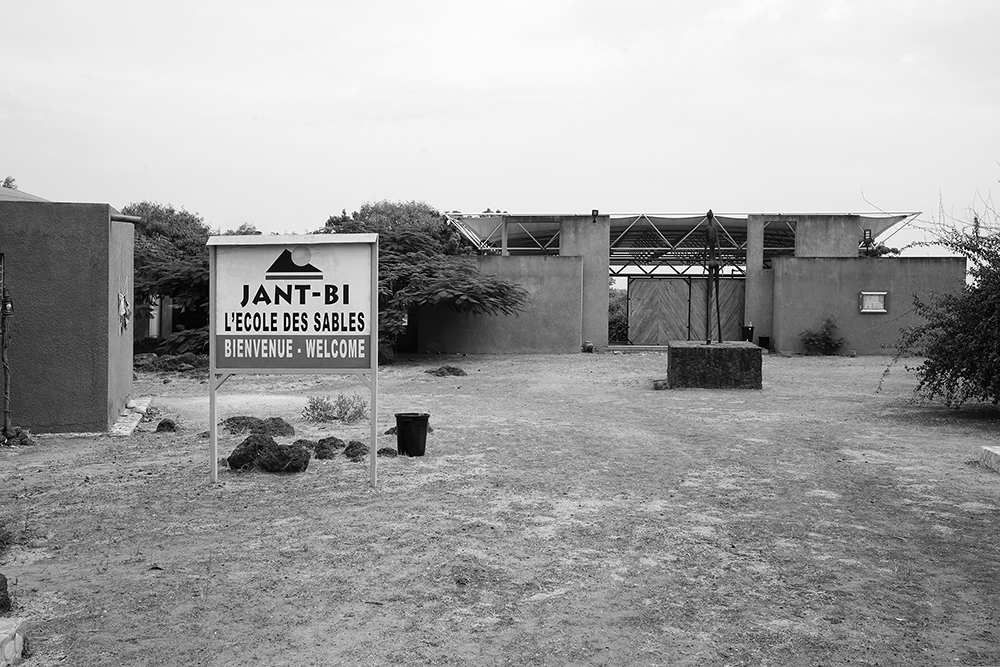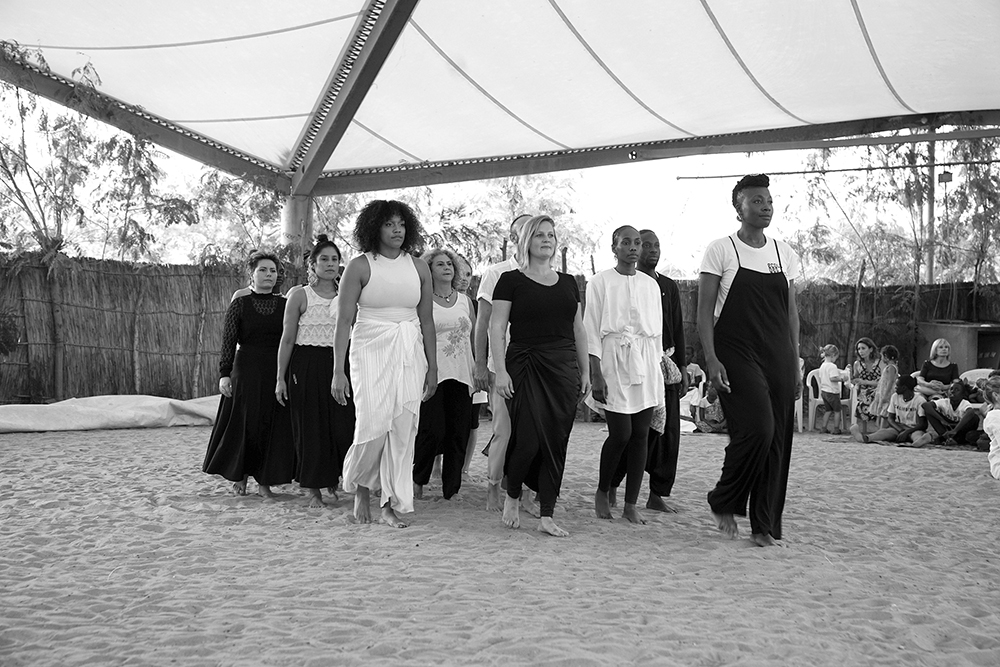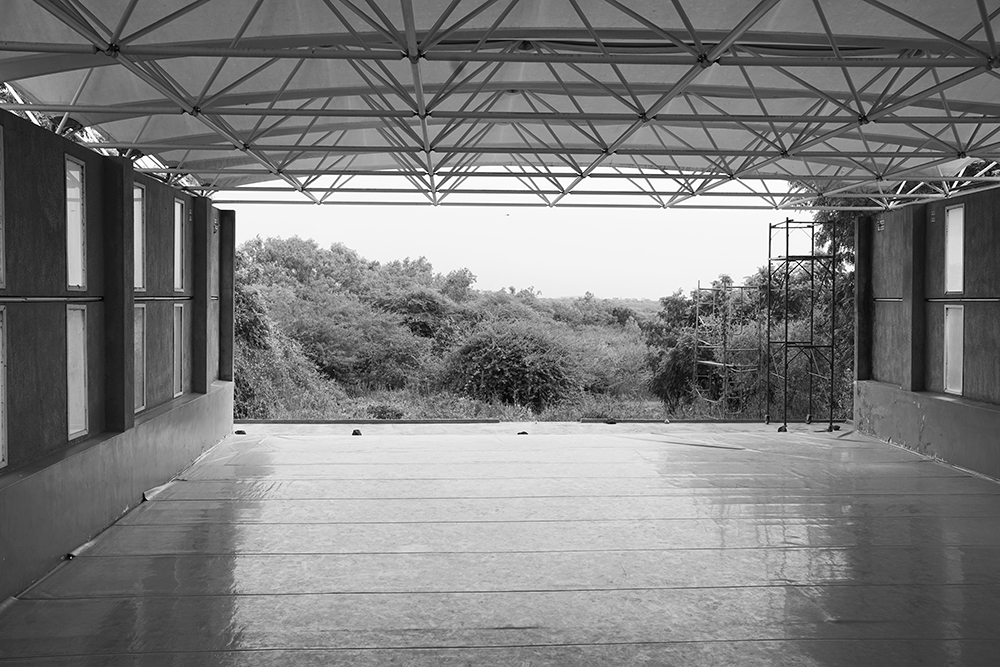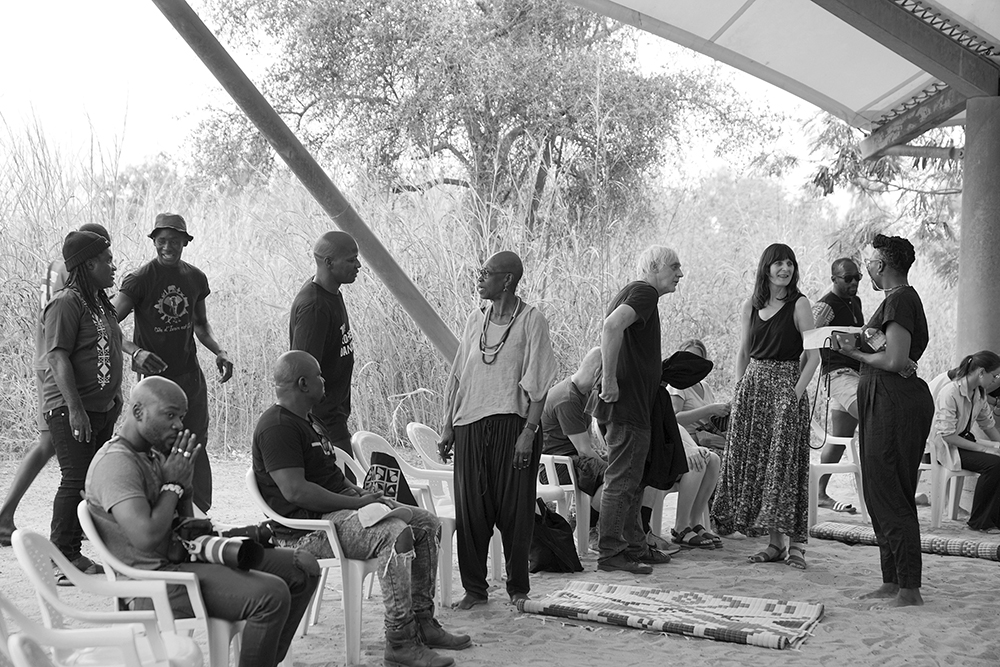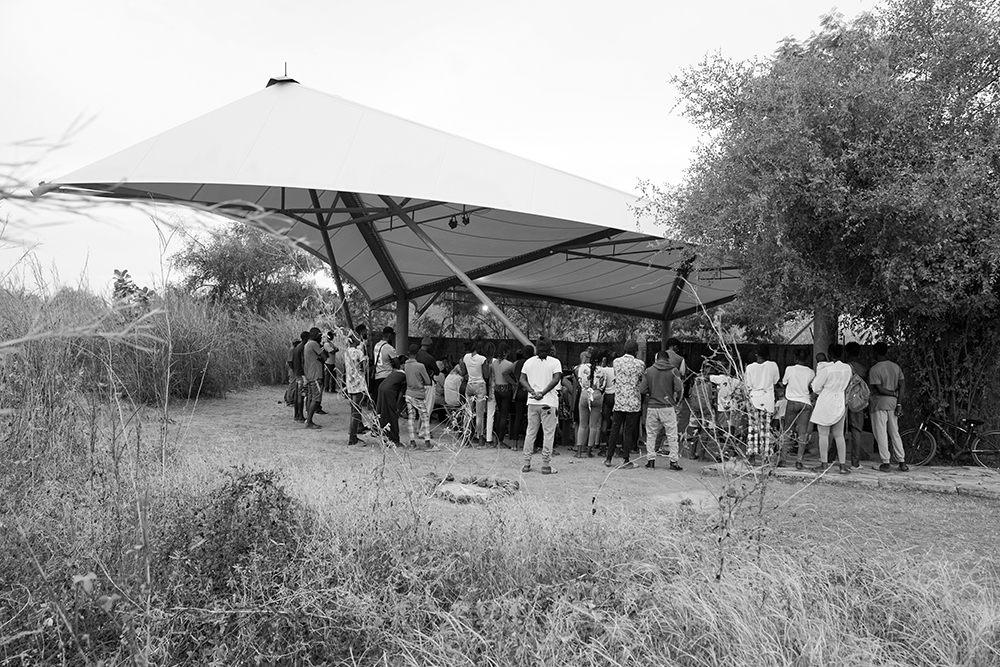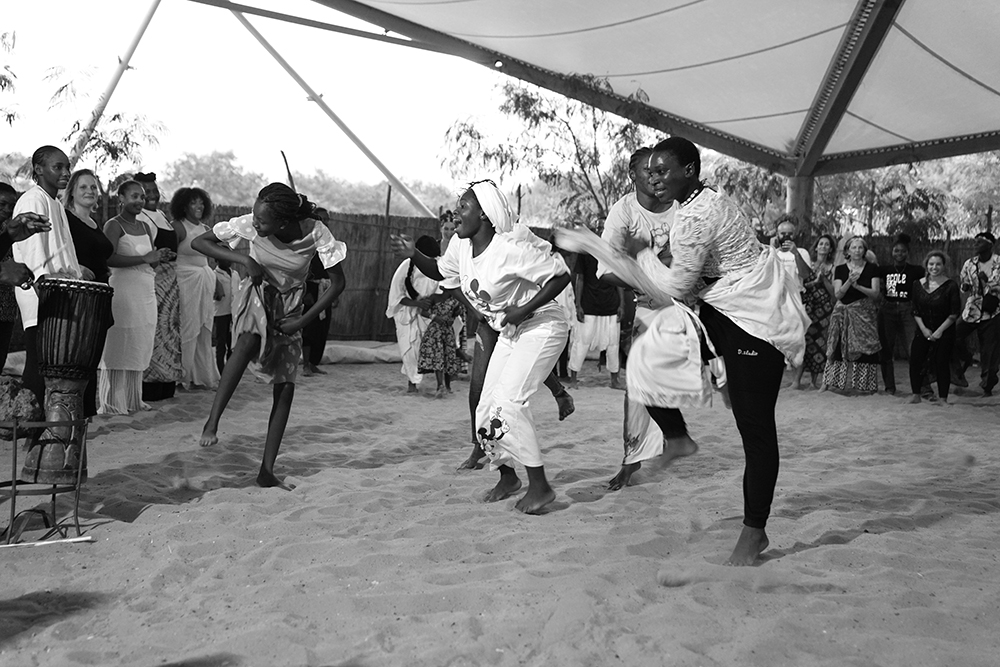Interview / École des Sables / Version 6
École des Sables is an international center for traditional and contemporary African dances, a school for theoretical and practical teaching, a research laboratory and place for meetings and exchanges, conferences and artistic residencies.
The association was founded in 1998 by dancer and choreographer Germaine Acogny—considered the mother of contemporary African dance—and her husband Helmut Vogt. Acogny, founder and director of Mudra Afrique (1977-1982) together with Maurice Béjart, set herself a goal, at an early age, to train responsible and independent African dancers.
On an area of 4.5 hectares, the École des Sables is located above the fishing village of Toubab Dialaw, 55 km south of Dakar, overlooking the ocean, a lagoon, and the savannah. The dance center consists of two large dance halls, one called Kër Aloopho, with a 400 m2 sand floor, and the other, Salle Henriette, with a 280 m2 Western professional floor.
In the different countries of Africa, dance is a means of transmitting traditions, the history of regions and peoples. The traditional dances of Africa are an essential part of the intangible cultural heritage. They are the living expression of beliefs and remind us of the development of these cultures. The Acogny technique conveys the idea that the dances of Africa are a constant dialogue with the cosmos. It focuses on the spine, an analogy to the snake or the tree of life. The main elements of this technique: a strong anchoring in the ground and the movements of the torso and spine (waves, shakes, contractions). Many of the movements are inspired by nature—plants or animals—but also by the elements of daily life in Africa. Germaine Acogny trains dancers to cast their traditional dances, heritage or family gestures, into a contemporary form.
Version: This is a very beautiful place here. Who did the architecture and at what time?
Alesandra Seutin:
The school was built in 1996 by a group of Paris-based architects—Architecture et Développement—led by Ludovic Jonar. The design is by Helmut Vogt, husband of Germaine Acogny, who had a vision and mapped it out. Everything is designed in such a way that you can always see nature, you always have a view of the horizon. When you sit in the restaurant and look at the studio, you also see everything behind it. There is a bench. When you sit on it, you look through the studio, at the nature. The students are never enclosed. So, there was always the idea that this place was built into nature, to live with it. When they started building here, there was nothing. There were only rocks—no trees, no life. Many people in the village said it was crazy to build here because no one would come. But then when they started to build, everything—plants and trees—started to grow.
Version: What is the idea behind this training center?
Alesandra: Germaine Acogny always wanted to create a home for dancers in Africa, to train and educate them and thus change their lives. Her vision was to emancipate African dance on its own continent and thus enter into international exchange. In the same way, dancers from all over the world should come here and return to their countries with the knowledge gained.
Version: Are the participants who come here already professional dancers?
Alesandra: There are different types of workshops. For example, the workshop that’s taking place right now is open to all levels. There are some professionals, some older and some in between. This workshop is open to anyone interested in Sabar dance, a Senegalese dance. But we also have a longer training for international professional dancers. There are workshops for students from Africa, and the African diaspora, who come here for ten weeks, three years, and then get a diploma. So, there are different types of workshops for all levels.
Version: There‘s also a company, right? We saw the Pina Bausch film that is currently
in cinemas.
Alesandra: I have been co-artistic director with Wesley Ruzibiza since October 2020. Before us it was Germaine Acogny and then Patrick Acogny, her son. And during their time there was Jant-Bi, a company based at École des Sables that toured the world, but sometime in 2015 it all stopped. When Wesley and I took over as artistic directors, we felt it was very important to restart the choreographic work with dancers in Senegal and the African continent, to create new visions. My connection to École des Sables came through exchanges with some dancers from the company that I met in London. Creating artistic works on top of all the educational work is a way to spread the vision of our artistic perspective, like with projects such as the collaboration with Pina Bausch Foundation and Sadler’s Wells. Touring projects also make people aware of École des Sables
around the world. So we decided to start again, but this time with the idea of creating two companies: Jant-Bi II, made up only of Senegalese dancers that we develop in some way and work with artistically, and then Jant-Bi | Germaine Acogny, with dancers from Africa and its diaspora, that tours more internationally. That‘s what we‘re working on at the moment. We have ten talented dancers from Senegal. Two of them participate in the Pina Bausch project. Most of the dancers in the Pina Bausch project have trained directly at École des Sables, others trained/worked with artists who were educated at École des Sables. There is an idea to tour in Senegal with Jant-Bi II to continue developing audiences for contemporary dance in Senegal and Africa. We are also already working on coproductions for a new work for Jant-Bi | Germaine Acogny, which will tour internationally.
Version: In the Pina Bausch project, you collaborated with the Tanztheater Wuppertal.
Pina Bausch created the idea of Dance Theater. You deal with traditional dance. How can you combine these two ideas? And what was the result of this collaboration?
Alesandra: I don‘t think it‘s so different. When people dance here, they dance with an intention, an expression and their life. I think it‘s the same thing that Pina did. She brought life onto the stage, not just movement. That‘s also what we‘re doing here. People bring their lives, their culture, their knowledge and stories. That‘s why we connect the sun, moon, and stars to the cosmos. It‘s about our existence and moving naturally with the body and still understanding that you are in space and you are causing something. This collaboration between the two institutions consisted of two components. On the one hand, dancers with training in African dance rehearsed Pina Bausch‘s choreography of Igor Stravinsky‘s Le sacre du printemps. On the other hand, former and current dancers of the Tanztheater Wuppertal acted as rehearsal leaders and shared their experiences with Pina Bausch and the choreography. I once asked the rehearsal directors how they brought the material closer to our dancers, to make them understand that it is a rite of spring. Sometimes they thought they had to explain something to the dancers from Africa so that they would understand the thoughts behind the movement. But basically, the piece communicated itself through the movement and music. We are used to thinking about why we move, what moves us. Are we moving toward something? I don‘t move for nothing. In a way our dancers had to relate to some of their own stories about the rite, the sacrifices. You sacrifice a lamb; the sacrifice is the idea of seasonal change. You sacrifice something for the sake of another cause. They could understand that and work with it. And there was no problem. The only thing that was an obstacle was maybe the ballet-oriented classical nature of the choreography because even though it‘s by Pina Bausch, it‘s very ballet-based. There was an attempt to convey that without imposing ballet on these bodies—the majority of which are not trained in ballet—but still be able to convey the clarity that they achieve with the Acogny technique. It‘s perhaps a different approach to space and interaction with self and others. But it‘s also still a codified form. So that has helped the majority.
Version: How do you make the connection between traditional and contemporary dance?
Alesandra: I can best speak for myself on that. I had training in contemporary dance and ballet. When I came here, I learned how valuable it is to go back to your own tradition to create a new language, to understand where you come from and to appreciate your heritage in order to create something new. When you know your own tradition, your own values, your own culture, it takes you further in art. That‘s really something I learned from this place and from Germaine Acogny‘s teaching: If you don‘t know where you‘re going, go back to where you came from. I always had the idea that I was looking outward, but I had to go back to myself to create my own voice and realize who I am, what my identity is. That‘s the concept, I would say.
Version: That seems to be a very important point in Africa or in Senegal: to find these
roots and connect with them.
Alesandra: Yes. A tree whose roots are not connected is dead, in a sense. So, if you look at yourself, the growing part of the world is rooted in your culture. If you are broken, in a sense you cannot grow.
Version: Is the village involved in the school‘s activities?
Alesandra: Without the village, there would be no school. Most of the women who work here are from the village. Also, now the whole world knows Toubab Dialaw and that means that the people who come here also come to the village. There is an exchange because the village benefits, in a way, from tourism and art and vice versa. We need the trust of the villagers. When we have a workshop, we go to the village council to introduce the group so that when the participants walk on the street, everyone knows that they are from École des Sables and, in a way, they are safe and doing well. It‘s like a family then. Our dancers are the children of the village as long as they are here.
Version: Do young people from the village also come to you to do classes?
Alesandra: Yes, the children are very important to us because they are our future. We work together with a school. In order for the children to come here, sometimes we have to go to the village. We do classes with the children on the street. It‘s about connecting with the village and its people. Every time there’s a birth, a wedding, or a death, Germaine goes and participates.
Version: How important is it for you to collaborate with different musicians and artists?
Alesandra: I think it’s very important. With one group, during the Dakar Biennial, we were there all the time, to get inspired. With the musicians it’s not always easy. I always try to invite musicians to try an exchange with our drummers. There is a culture of drumming and theater here in Senegal, but not necessarily of contemporary music or composing. For example, I brought my composer, Randolph Matthews, who works primarily with voice, here for a workshop. In my practice, I work with voice and movement. It was interesting how he talked with some of the young drummers and dancers about how to compose music and what sounds to use to support the composition. The drummers know how to play a rhythm, but composing for dance is something else. With the bass rhythms they give the basic energy, but as soon as a solo comes in, or the dancers react directly to the music, they should be able to respond to it. It‘s about interaction. I really try to work with them on the idea of rehearsing something and then playing the same thing again because there are problems. We also have two that play the kora. They are more curious to use other instruments as well. We need to work more with our musicians on their creativity because they just need to be able to contribute in some way.
Version: Dance always has to do with space and time. So, you also work with architecture and you have different places where you can work differently.
Alesandra: I also work in specific spaces everywhere throughout the school. Each space has different shapes and energies that need to be contrasted. At one of the last performances—it was rather a quiet lesson—the audience walked around the room. They were led to different rooms, first to a smaller one and then to the largest. This allowed them to experience that different spaces can be perceived sonically and visually.
Version: And do the students also have their own choreographies?
Alesandra: Yes. And there are also companies that come here for residencies—to observe and work, and to exchange, all that happens here.
Version: Could you tell something else about the idea of connecting movement and cosmology? Because that‘s a fundamental idea of Germaine‘s dance.
Alesandra: It‘s more about the idea of animism. That was the first „religion“ before other religions came and colonized certain ideas. Animism meant appreciating nature. Everything that is given to us from the ground, from the earth. There was not necessarily a particular god or soul. Germaine is still entrenched in that value because she comes from a Yoruba culture that still lives animism. The cosmos is all around us. When we dance here, we value the idea that the cosmos is within us. The idea is that the world doesn‘t work if you‘re not aware of that. The sun doesn‘t rise, the moon doesn‘t set, there‘s a kind of dysfunction. It‘s the same if you imagine that your chest is your sun, your pelvis and your pubic area are your stars and your moon, and your spine is your tree of life. So, when you move and walk or dance, everything should work together. In other forms of dance, we tend to block. If you close off your torso area, which I also call your emotional box, you can‘t express yourself, you‘re not living in a sense. When you let go and connect with the ground, and allow the cosmos to move along with you, you enter the space with a different energy. And that‘s really what it‘s about. It‘s about expression and connecting with the ground and how that vibration gets into your body and then into the space, which is a very performative element. You really feel a difference depending on whether you open the space or close the space. It‘s also just about bringing awareness back to your own body.
